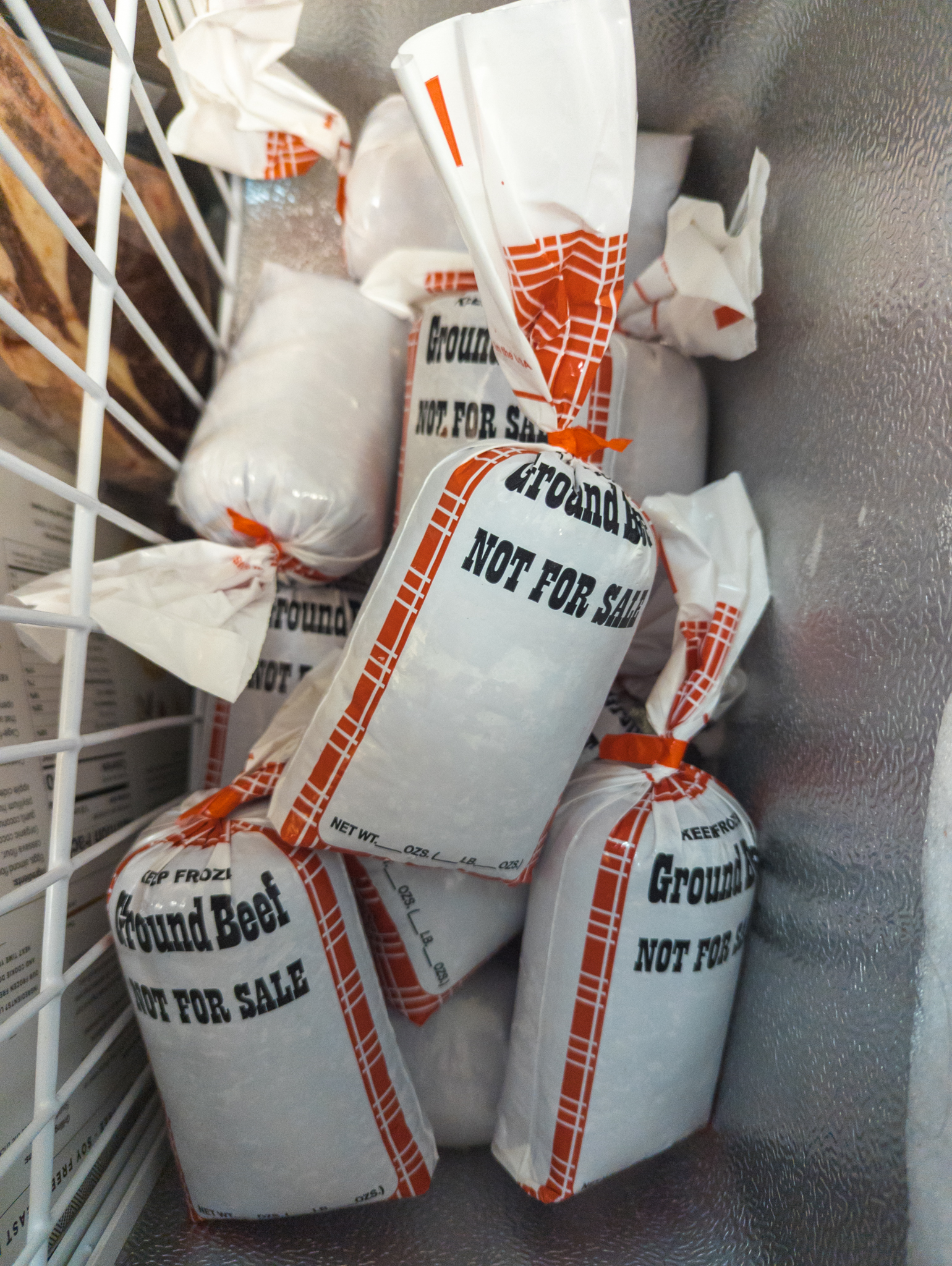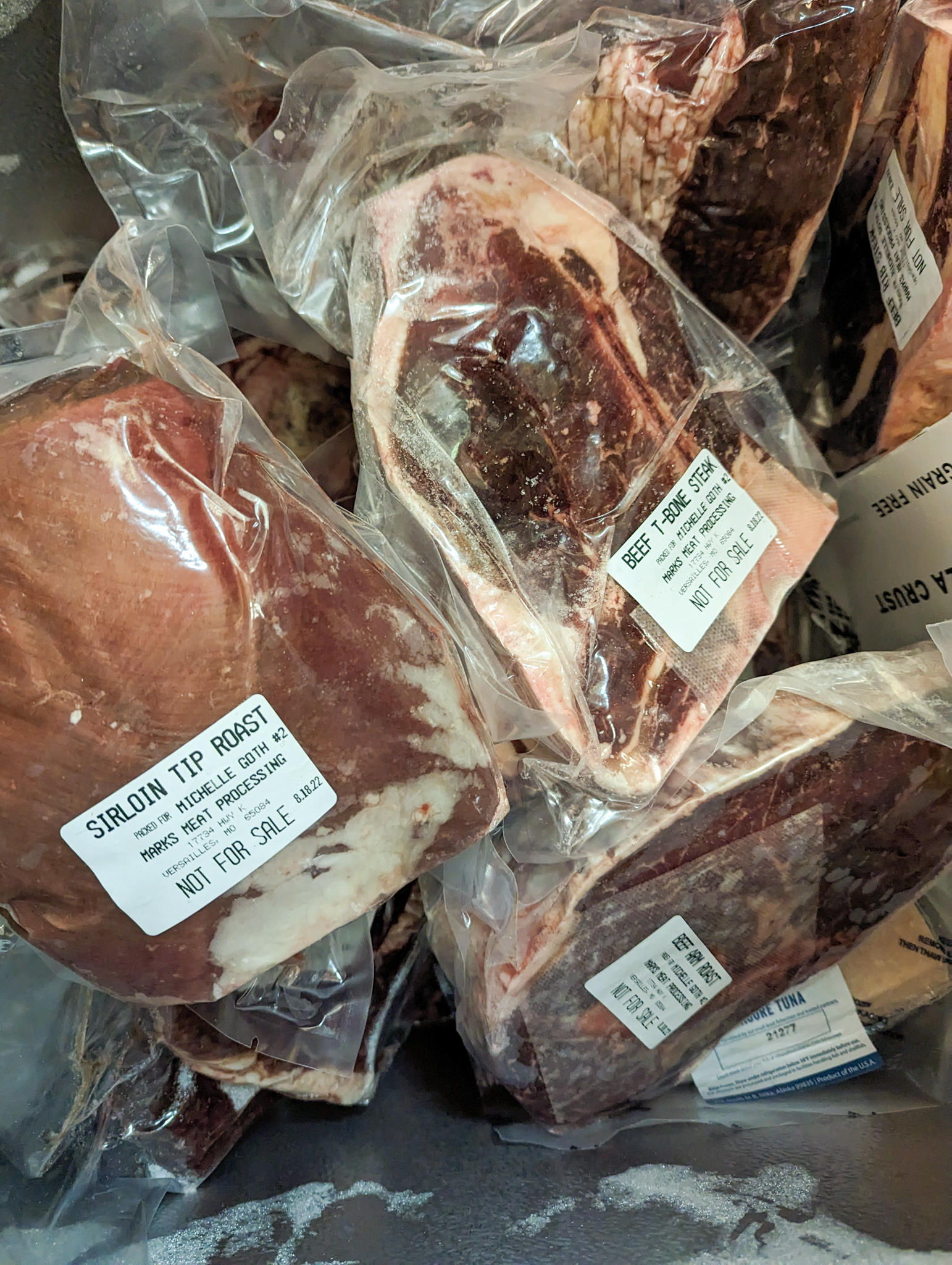Are you thinking about buying a quarter cow? This post talks about how I bought a half cow and split it with some friends. I include the cost, final weight and what questions to ask your farmer and processor!.
Last summer, I took a big leap and purchased a quarter beef. To be honest, I was scared the whole time! But when I saw how much beef was going up in stores, I decided to do something. I knew that we could do better on price if we went direct to the farmer.
I was raised on beef direct from the farm, and I knew it tasted better. But, the process of buying direct was intimidating, and I just didn’t know where to start!.
There are two key parts to buying beef direct. First, you need to find a farmer. Second, you need to find a processor (a butcher) who can take the cow when it’s ready and a good weight.
Check out my tips, costs and lessons learned below. Sorry this post is so long! You can click on the links to go straight to the part you need help with.
Ordering a quarter side of beef can be an exciting and economical way to stock up your freezer with high-quality cuts of meat. However most people have questions about the true cost and amount of meat they will receive. In this comprehensive guide we will break down exactly how much a quarter beef costs, how many pounds of meat you can expect, what cuts are included, additional fees, and any other questions you may have about the process.
The Cost of a Quarter Side of Beef
The price for a quarter side of beef can range anywhere from $500 to $1300 depending on the weight, breed, butcher fees, and other factors The main costs include
-
Cost of the live steer: This is what the farmer charges for their animal. Prices are usually based on live weight, hanging weight or sometimes per pound.
-
Butcher or processing fees: The butcher will charge you per pound for cutting, wrapping and freezing the beef. This fee is usually $0.60-$1.00 per pound.
-
Beef breed: Specialty breeds like Angus, Hereford or Wagyu will be more expensive than regular commercial beef cattle.
-
Weight of the beef: The more your quarter side weighs, the more it will cost. Average weight is around 175-200 lbs for a quarter.
-
Additional fees: Some butchers charge fees for delivery, packaging, cured items, etc. Ask for a complete price breakdown.
To give you a real world example, our farm charges $5.50 per pound hanging weight. With an average quarter weighing 175-200 lbs, the total cost would be $962-$1100 for the beef plus 1% sales tax. The butcher we work with charges $85 processing for a quarter beef. So with those average weights, the total cost would be around $1047-$1185 for a complete quarter side of beef.
How Much Meat Will You Get?
You can expect to bring home 125-150 pounds of packaged beef from a quarter side. Remember you are only paying for the hanging weight, which will be more than the final packaged weight. Here’s why:
-
Bone loss: The bones are removed so you don’t pay for those. This accounts for 20-25% loss.
-
Trimming: The butcher will trim off excess fat and waste. Figure 5-10% loss from trimming.
-
Moisture loss: Freezing and packaging removes moisture, so count another 5% or so in losses.
Going back to our example of a 200 lb hanging weight, you would probably get around 150 lbs of packaged beef after processing. That comes out to around $7/lb for your packaged beef. Keep in mind these are estimates and actual amounts will vary.
What Cuts Are Included in a Quarter Beef?
One of the best things about ordering a quarter beef is you can customize the cuts to your preferences. Here are some of the cuts you can expect to receive:
Front Quarter Cuts:
- Ribeye steaks
- Chuck roasts
- Short ribs
- Brisket
- Ground beef (30-40 lbs)
Hind Quarter Cuts:
- T-bone steaks
- Sirloin steaks
- Round steaks
- Rump roasts
- Ground beef (30-40 lbs)
You’ll also get some soup bones, organ meats like liver or tongue if desired, and the option for patties made from your ground beef. When ordering, the butcher will go over all the cutting options and thicknesses. Don’t worry if you aren’t sure what to choose, most are happy to make suggestions based on your family’s needs.
Freezer Space Needed
A typical household quarter beef will need 7-9 cubic feet of freezer space for storage. That is about the size of a small-medium chest freezer. If you plan to order larger quantities of beef, make sure you have enough room in your current freezer or budget for a new one.
Our butcher vacuum seals and hard freezes everything for maximum freshness. Kept frozen at 0°F, your beef can last 12 months or longer. Label packages with the cut and date before freezing so you know what needs to be used first.
The Ordering Process
Ordering a quarter beef is simple. Here are the basic steps:
-
Contact the farm or butcher and place your order. A deposit is usually required up front.
-
Discuss cutting instructions – number of steaks, roasts, etc.
-
Wait 3-4 weeks for processing. Large orders may take longer during busy season.
-
Pick up your beef when it is ready. Inspect the quality before taking it home.
-
Pay any balance due for the hanging weight and processing fees.
-
Get ready to fill your freezer! Brief thawing and refreezing won’t affect quality.
Is Buying a Quarter Beef Worth It?
Ordering a quarter beef has many benefits beyond the price per pound. Here are a few good reasons to buy bulk beef:
-
Quality: Beef bought direct from local farms is usually superior. You can see how the cattle are raised.
-
Custom ordering: Perfectly tailored packages with your favorite cuts.
-
Cost savings: Bulk buying provides savings $2/lb or more over grocery store beef.
-
Supports local farms: Your money stays in the community and contributes to a more sustainable food system.
-
Reduced waste: Buying and freezing bulk portions reduces packaging waste. Use all parts of the animal.
-
Better for budgeting: Pay upfront instead of weekly grocery bills. Eat premium beef for the same price as lower quality store beef.
As long as you have the freezer space, ordering a quarter side of beef is one of the best values for your food budget. You get high quality, locally raised beef at bulk pricing. Just be sure to account for all costs involved so you can budget accordingly.
Frequently Asked Questions
Q: Can I order just a front or hind quarter?
A: Some farms may allow you to order half of a side (1/4 beef) but most require full quarters to make processing efficient. Talk to your farmer.
Q: What about bone-in vs boneless cuts?
A: Your preference! Bonless is easier for storage but bone-in often tastes better. Get a mix for versatility.
Q: Is grass-fed beef more expensive?
A: Yes, you can expect to pay 15-30% more for certified grass-fed beef. It offers a leaner, more robust flavor.
Q: Who covers the cost if I’m not satisfied with the quality?
A: Reputable farms and butchers will make things right if you are unsatisfied. Always inspect before taking possession.
Q: Can I get dairy beef like steers raised on a dairy farm?
A: Yes, dairy beef is delicious and usually very well marbled. Just connect with local dairy farmers in your area.
Q: What is the most economical beef option?
A: Ordering a quarter beef provides the best price per pound. Buying half a cow can save even more but requires double the freezer space.
Ordering a quarter side of beef is hands down one of the best ways to save money on premium cuts of meat. Now that you know what to expect with costs, quantities and the ordering process, you can decide if buying part of a whole cow fits into your family’s budget and meal plan. Happy grilling!

Questions for the Processor:
- What are the processing costs (butchering fees)? Cost per pound?
- Are there extra fees for adding fat to ground beef? Let them know if you want ground beef in 1-pound or 2-pound packages. They can generally accommodate any request for package size.
- Could you put my name and any other information you want on, please?
- When can I pick up the beef after it has been butchered? Note: Most processors let the beef hang for a few weeks before cutting it into individual cuts. Some meat processors age the meat for even longer, adding months to its age.
- Will the meat be frozen? Should I bring coolers or ice? Note: For our half beef, we brought four medium-sized coolers, which worked out great.
- What kinds of payments do you take? Do you take credit cards? Note that some places only take cash.
- When do I pick it up?

Deciding what cuts you want:
Make sure to tell the processor about any special cuts you’d like when you talk to them.
You can make a standing rib roast with rib-eye steaks that are still whole, or you can have some cuts ground up instead of left whole.
The processor will likely ask you the following questions, so think about these questions ahead of time:
- Note: If you don’t want short ribs and stew meat, this can all be turned into ground beef.
- Want some soup bones? Keep in mind that this can only be used to make your own broth. If they won’t do this, have them cut the meat up and make ground beef.
- Would you like steak cuts like flank steak and hanger steak that most people don’t like?
- What kind of sirloin do you want? Should it be left as roasts, cut into sirloin tip steaks, or left as bits and pieces like for beef stroganoff?
- What kind of steaks do you want? Specifically, do you want T-Bone steaks or would you rather have them cut into strip steaks and filet with no bone?
- How thick do you want your steaks? Most people choose 3/4 inch or 1 inch, but they can make them any way you want. Remember that if you ask for thicker steaks, you’ll get less of them!
- Would you like your ribeye steaks to be cut into steaks or left whole for a ribeye roast with the bone in?
- Could you tell me how much fat you’d like added to your ground beef? 3%, 5%, 2010, 2015, 2020, and 20%E2%80%9Cas%20lean%20as%20possible%E2%80%9D are all good answers. The butcher gave us 2093% lean beef and 7% pork fat after I asked for it to be as lean as possible.
- Would you like to keep any organ meats?
- Should I make round steak or cube steak? If you choose round steak or cube steak, this Easy Crock Pot Round Steak recipe will make them nice and tender. Keep in mind that these are tougher cuts, so you’ll need to cook them in a way that makes them tender. Not going to use these cuts? You can ask to have them ground up instead.
Keep in mind that whatever cuts you opt out of can be converted into ground beef.
You can say no if you won’t use a cut but will use it to make ground beef!

